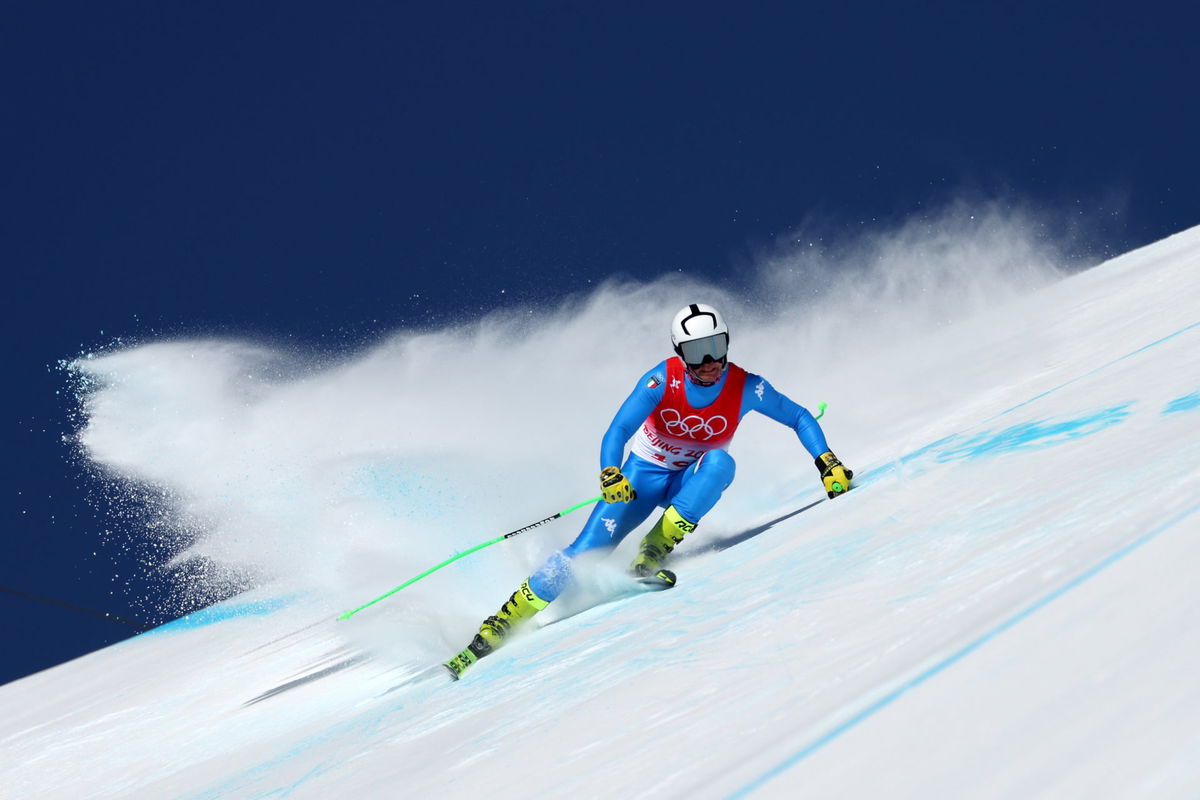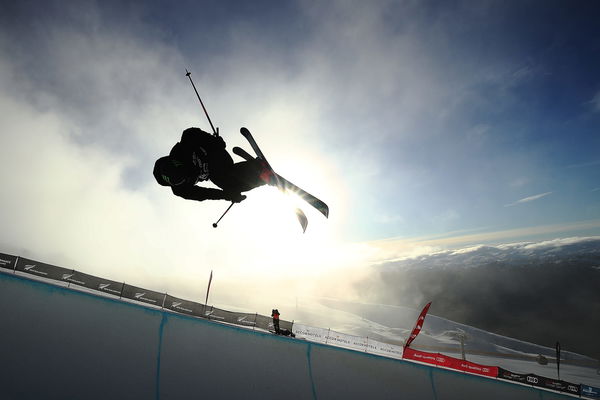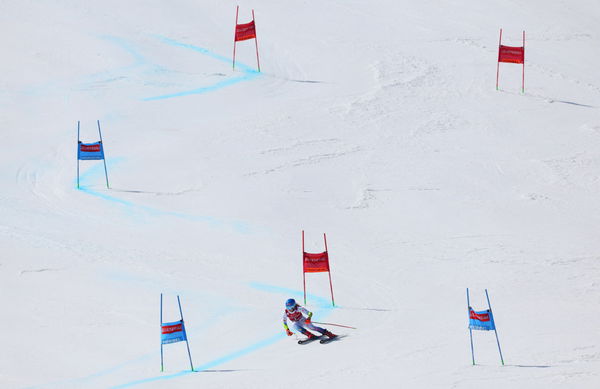
Getty
YANQING, CHINA – FEBRUARY 04: Matteo Marsaglia of Team Italy skis during the Men’s Downhill 2nd training session ahead of the Beijing 2022 Winter Olympic Games at National Alpine Ski Centre on February 04, 2022 in Yanqing, China. (Photo by Tom Pennington/Getty Images)

Getty
YANQING, CHINA – FEBRUARY 04: Matteo Marsaglia of Team Italy skis during the Men’s Downhill 2nd training session ahead of the Beijing 2022 Winter Olympic Games at National Alpine Ski Centre on February 04, 2022 in Yanqing, China. (Photo by Tom Pennington/Getty Images)
The thrilling exhilaration of swooshing down the snow-covered mountain at high speeds is a feeling adored by millions. Alpine skiing is a sport that embodies this very thrill. Yet one must ponder: what would be the purpose of this sport if there wasn’t any snow? Over the years, skiing and snowboarding have become major topics of discussion in relation to climate change.
Watch What’s Trending Now!
The construction of ski resorts, the building of lifts and lodges, the creation of artificial snow, transportation, a certain amount of deforestation, the use of fossil fuels, and many other reasons have all contributed to environmental concerns. The sport relies on snow, and the depletion of this main natural resource due to climate change has sounded a clarion call for immediate action.
ADVERTISEMENT
Major move made by Skiing Athletes demanding action on climate change
In February 2023, nearly 200 athletes from the different disciplines of winter sports, including Mikaela Shiffrin, Federica Brignone, and Aleksander Aamodt Kilde, issued a letter to the International Ski Federation (FIS) demanding action on climate change. “We see that the world is changing. We see also the impact of our sport. … I want the future generations to experience winter and to be able to do what I do,” said Aleksander Aamodt Kilde. Even the legendary Mikaela Shiffrin highlighted this in an interview, saying, “I feel like there’s going to be a point in my career where I maybe stop just because … I can’t be taking this travel for granted and contributing so much to our global carbon footprint.”
This letter was sent during the skiing world championships after the sport received a major lack of snow during the warmer months. The athletes also petitioned the International Ski and Snowboard Federation to shift the sporting events to align with the weather patterns and season, to reduce travel, to make climate-smart decisions, to make climate-friendly options for spectators, and to raise awareness about the situation.
Top Stories
Forced to Leave FOX, Cowboys Legend Troy Aikman Says ESPN Is Like ‘U.S. Government’ & Clearly Distinguishes the Two Networks

Who Is Paige Shiver? All About Michigan Football Staffer & Daughter of Veteran Bears Scout Jeff Shiver

FOX Issues Strict Ban on Terry Bradshaw But NFL Legend Defies It to Join Popular Morning Show

$250M Michigan Booster Names Super Bowl-Winning HC as Better Fit to Replace Sherrone Moore Than Kalen DeBoer

Michael Jordan Brings NASCAR to Its Knees as Jim France’s Courtroom Collapse Triggers Settlement

What Happened to T.J. Watt? Why Is He Hospitalized? Steelers Announce Latest News on LB Before Dolphins Game


Getty
CARDRONA, NEW ZEALAND – SEPTEMBER 01: Beau-James Wells of New Zealand competes during the Winter Games NZ FIS Men’s Freestyle Skiing World Cup Halfpipe Finals at Cardrona Alpine Resort on September 1, 2017 in Cardrona, New Zealand. (Photo by Hannah Peters/Getty Images)
Later in the year, FIS responded to the organization ‘Protect Our Winters’ and stated the major changes it had taken to put sustainability at the forefront of all its actions. As a signatory to the UN Sports for Climate Action Framework (UNFCCC), FIS committed to reducing its carbon emissions by 50% by 2030 and aimed to calculate CO2 emissions for a reduction plan. The FIS has also shared its initiative to raise awareness among the national associations to cut emissions and reduce their impact. In a bold move, the total fluor wax ban, which was passed by FIS in November 2019, saw major development in 2023, just in time for the Audi FIS Alpine Ski World Cup.
ADVERTISEMENT
ADVERTISEMENT
New rules by the International Ski Federation make waves
According to Ski Racing, new testing technology is proving to be proficient after the slow implementation of the total fluor wax ban. Earlier, the fluor wax ban was subject to laggy implementation due to a lack of reliable technology and the tools for detection. At the Audi FIS Alpine Ski World Cup and the FIS Junior World Ski Championships, regular testing is being implemented to better the enforcement of the ban. The Fluor Equipment Controller of the FIS Control Team set up testing tents next to the finish area exit gate. In addition to this, before the season, testing opportunities would allow service personnel to determine if the skis would be clear and allowed to be used for the races.
The Fluor Equipment Controller also set up three camps: one for the ski equipment to be tested, one to detect fluor-negative skis, and one called “Red Fluor” for skis that fail the test and are detected for the presence of fluor. This testing wasn’t just imposed in skiing but in all FIS disciplines. And it was not just intended to prohibit fluorinated wax but also for tuning products containing fluorine. The measuring procedure would have a few steps to determine the presence of the banned fluor and would test one ski from each pair.

Reuters
Alpine Skiing – FIS Alpine Ski World Cup – Women’s Giant Slalom – Courchevel, France – March 20, 2022 Mikaela Shiffrin of the U.S. in action REUTERS/Denis Balibouse
This ban and test have been made compulsory due to the competitive advantage the wax provides and, secondly, the carcinogenic and environmentally detrimental effects of fluorine. This major ban and testing caused waves recently when Norway’s Ragnhild Mowinckel became the first skier to be disqualified for the banned fluorine present in the wax on her equipment.
ADVERTISEMENT
Mowinckel is an Olympic silver medalist from the Pyeongchang Games in 2018. She made it to sixth place on her first run of the giant slalom at the Audi FIS Alpine Ski World Cup. However, after the mandatory post-run test by FIS, the detection of the banned fluorine on her equipment resulted in her disqualification. In an interview, the disheartened athlete said, “We must find out what happened. We are not trying to cheat because that’s the worst thing for me”.
ADVERTISEMENT
Although this news came as a major upset to her and her fans, it shed the spotlight on the bold and stringent rules put forward by the FIS to ensure environmental health and safety. As winter sports begin in full swing, proactive measures taken by the Federation might just revolutionize the sport for the better, keeping the health of the environment and the sustainability of the sport at the forefront. But will this be enough to protect the environment? Let us know what you think. Comment below!
Watch this story: 7x Skiing World Champion Mikaela Shiffrin’s Intense Workout Routine Challenges Michael B. Jordan’s ‘Creed’ Physique
ADVERTISEMENT
ADVERTISEMENT
ADVERTISEMENT

